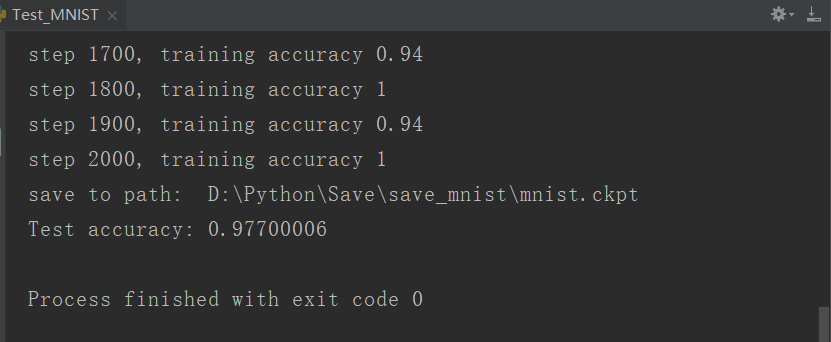前提是对TensorFlow有了基本的了解,还有神经网络相关知识最基础的了解,下面直接用代码实现
import tensorflow as tf
import numpy
from tensorflow.examples.tutorials.mnist import input_data
mnist=input_data.read_data_sets("D:\Python\MNIST_data", one_hot=True)
#添加x作为占位符
x=tf.placeholder("float", [None, 784])#28*28
#正确结果占位符
y_=tf.placeholder("float", [None,10])
#生成权重函数
def weight_variable(shape):
#tf.truncated_normal(shape, mean, stddev) :shape表示生成张量的维度,mean是均值,stddev是标准差。这个函数产生正态分布,均值和标准差自己设定
#权重在初始化时应该加入少量的噪声来打破对称性以及避免0梯度
initial=tf.truncated_normal(shape, stddev=0.1)
return tf.Variable(initial,dtype=tf.float32)
#生成偏置函数
#由于我们使用的是ReLU神经元,因此比较好的做法是用一个较小的正数来初始化偏置项,以避免神经元节点输出恒为0的问题(dead neurons)
def bias_variable(shape):
initial=tf.constant(0.1, shape=shape)
return tf.Variable(initial,dtype=tf.float32)
#卷积函数
#卷积使用1步长,0边距的模板,池化用2x2的模板
def conv2d(x, W):
#x:待卷积的矩阵具有[batch, in_height, in_width, in_channels]这样的shape
#w:卷积核具有[filter_height, filter_width, in_channels, out_channels]这样的shape
#strides:卷积时在图像每一维的步长,这是一个一维的向量,长度4
return tf.nn.conv2d(x, W, strides=[1, 1, 1, 1], padding='SAME')
#池化函数
#和卷积基本相同
def max_pool_2x2(x):
return tf.nn.max_pool(x, ksize=[1, 2, 2, 1],strides=[1, 2, 2, 1], padding='SAME')
#卷积在每个5x5的patch中算出32个特征。
#卷积的权重张量形状是[5, 5, 1, 32],前两个维度是patch的大小,
#接着是输出几个单位,和输出的几个维度
W_conv1=weight_variable([5, 5, 1, 32])
b_conv1=bias_variable([32])
#shape:[batch, in_height, in_width, in_channels]
x_image=tf.reshape(x, [-1,28,28,1])
#卷积+偏置,然后给relu激活函数,最后激活函数返回值池化
h_conv1=tf.nn.relu(conv2d(x_image, W_conv1) + b_conv1) #output size 28*28*32
h_pool1=max_pool_2x2(h_conv1) #output size 14*14*32
#第二层卷积,池化
W_conv2=weight_variable([5, 5, 32, 64])
b_conv2=bias_variable([64])
h_conv2=tf.nn.relu(conv2d(h_pool1, W_conv2) + b_conv2) #output size 14*14*64
h_pool2=max_pool_2x2(h_conv2) #output size 7*7*64
#全连接层1
W_fc1=weight_variable([7*7*64,1024])
b_fc1=bias_variable([1024])
h_pool2_flat=tf.reshape(h_pool2, [-1,7*7*64])
h_fc1=tf.nn.relu(tf.matmul(h_pool2_flat,W_fc1) + b_fc1)
#dropout方法减轻过拟合问题
keep_prob=tf.placeholder("float")
h_fc1_drop=tf.nn.dropout(h_fc1, keep_prob)
#全连接层2
W_fc2=weight_variable([1024, 10])
b_fc2=bias_variable([10])
y_conv=tf.nn.softmax(tf.matmul(h_fc1_drop, W_fc2) + b_fc2)
#训练和评估、保存模型
cross_entropy=-tf.reduce_sum(y_*tf.log(y_conv))
tf.summary.scalar('cross_entropy',cross_entropy)
train_step=tf.train.AdamOptimizer(1e-4).minimize(cross_entropy)
correct_prediction=tf.equal(tf.argmax(y_conv,1), tf.argmax(y_,1))
accuracy=tf.reduce_mean(tf.cast(correct_prediction, "float"))
tf.summary.scalar('accuacy',accuracy)
sess = tf.InteractiveSession()
sess.run(tf.initialize_all_variables())
saver=tf.train.Saver()
merged=tf.summary.merge_all()
writer=tf.summary.FileWriter('D:\Python\Save\logs',sess.graph)
sess.run(tf.global_variables_initializer())
for i in range(2001):
batch = mnist.train.next_batch(50)
if i% 100 == 0:
train_accuracy = accuracy.eval(feed_dict={x:batch[0], y_: batch[1], keep_prob: 1.0})
print("step %d, training accuracy %g"%(i, train_accuracy))
train_step.run(feed_dict={x: batch[0], y_: batch[1], keep_prob: 0.5})
summary_str = sess.run(merged,feed_dict={x: batch[0], y_: batch[1], keep_prob: 0.5})
writer.add_summary(summary_str,i)
save_path = saver.save(sess,'D:\Python\Save\save_mnist\mnist.ckpt')
print('save to path: ',save_path)
accuracyResult = list(range(10))
for i in range(10):
batch = mnist.test.next_batch(1000)
accuracyResult[i] = accuracy.eval(feed_dict={x:batch[0],y_:batch[1],keep_prob:1.0})
print("Test accuracy:", numpy.mean(accuracyResult))运行的实验结果:
